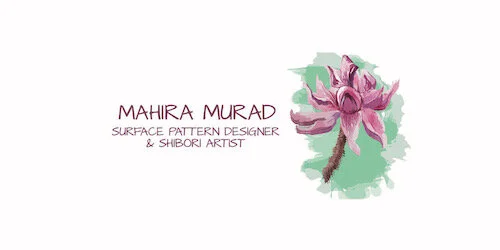The art of shibori dyeing with Mahira Murad
Today I'm sharing the second part of an interview I did with Mahira Murad where she talks about shibori, a Japanese fabric dyeing technique. Find out how it defines her signature style, and learn how you can experiment with shibori yourself.
And if you missed, it, read the first part of this interview where you can learn about Mahira and her journey as a freelancer. Enjoy!
How would you describe shibori to someone who's never heard about it?
Shibori is a technique originating in Japan and it is a Japanese word meaning ‘to resist’. Certain kind of tools and specific techniques are used to manipulate fabric in ways that a resist is formed within the fabric and then it is dyed. The resist prevents dye from reaching all of the fabric.This form of resist dyeing can achieve very beautiful organic effects on fabric surfaces.
Mahira Murad shibori
Why do you find it appealing?
First of all, shibori appeals to me because it has to do with hand dyeing and fabrics. I love working with those mediums as a textile artist.Second, I find that shibori offers endless opportunities for experimentation. I can play around with different fabrics and try different types of resists. I create resists using threads, cords, ropes. I even experiment with wooden block resists (the itajime technique) and play around with both hand and machine sewing.
How did you learn the technique?
I was introduced to shibori while studying at Moore college of Art and Design in Philadelphia. I discovered a wonderful book by Yoshiko Wada (a pioneer and supporter of this ancient technique) and instantly fell in love with her introduction to the myriads of ways you can learn and experiment with shibori. The book gave me the freedom to work with this technique which I discovered offers endless possibilities.
I started with Arashi shibori (Pole wrapping) where the fabric is wrapped around a circular tube with the help of thread/cord and then scrunched (resulting in pleats) and dyed. The resulting pattern is an organic stripe effect. The end design varies greatly depending on the thickness of the fabric, how many layers of fabric are wrapped around the pole , the weight of the thread/cord, and how much space you leave as you wrap the thread/cord around the fabric. Over time I have experimented with several different shibori techniques and now combine several of them to achieve my signature style.
How would you recommend someone start out with shibori?
I would advise anyone just starting out with shibori to try it with cotton fabric and fiber reactive dyes and just play around. You can find basic instructions in any shibori book. Once you get a feel for how shibori works, embrace your creativity and start experimenting and searching for how you can make it your own. Just experiment, experiment, experiment until you find a way of doing the shibori technique that speaks to you. That will be your signature style.
Mahira Murad shibori
Can you tell us a bit about your signature shibori style?
I have been doing shibori now for several years and through experimentation have found a style that speaks to me. I introduce several layers of dyeing and discharging color to achieve certain effects. But my signature style has started to evolve gradually as I try to combine other shibori techniques to it. I strive to not only have a signature style but to always be actively introducing something new and fresh so that this age old technique has a contemporary vibe.
Any tips for someone who has never dyed fabric before?
For someone who has never dyed fabric this is going to be a challenge. They need to understand the types of dyes and fibers that are out there before jumping into shibori. That said, hand dyeing is not rocket science. It can be mastered with a little bit of research and experimenting. Start basic...Dharma trading is a good place to start. Good luck!



